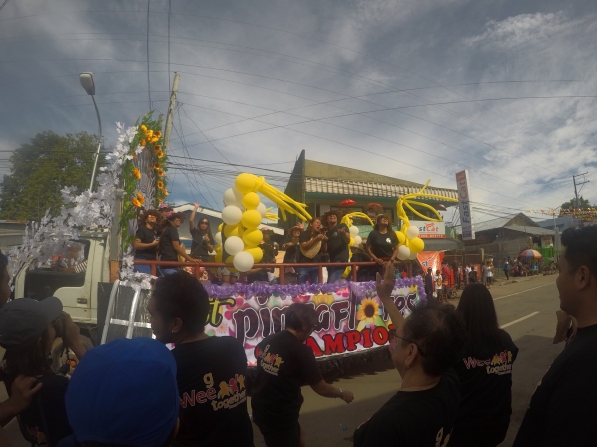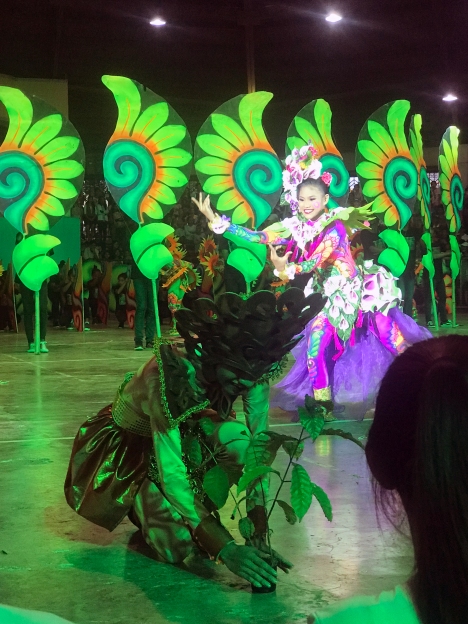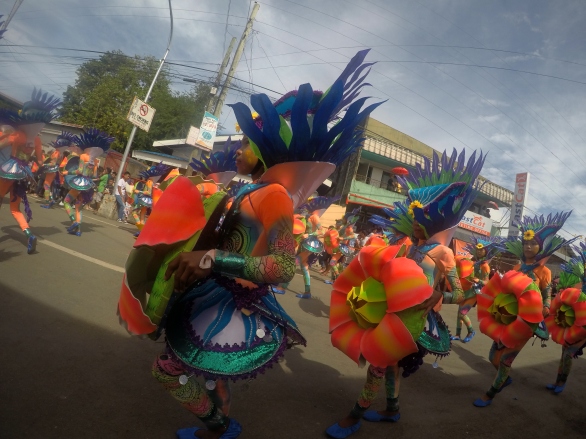November 5, 2018: Today, a legally ordained no-work holiday across Negros Occidental, is the Pintaflores Festival street dance competition & flower dance rituals in the San Carlos City auditorium. Costumed as flowers, plants, stems, roots, trees, princesses, priestesses, paper bags & nature-worshipping peoples, the streets of this quiet port city (what one resident described as “normally a ghost town”) have now erupted in the height of carnival celebration.

I felt incredibly blessed to be here & now – and at the same space-time, I innately feel transported to alternative realm. The concept of ‘liminality,‘ as used by early anthropologist of performance Victor Turner, describes the space of ‘in-betweenness‘ which ritual conjures. Yet, in attempting to re-member my experience of Pintaflores, ‘liminal’ would be too weak of a word; I felt the past projected in future worlds.

Plural histories constitute the ritual of Pintaflores (1) a celebration for the beloved pre-Spanish settler-colonial princess “Nabingka” & her Negrito peoples of “Nabingkalan” cured by tattooed & planted flowers; 2) a feast day for San Carlos Borromeo, the Catholic saint whom the town is renamed after by a Spanish priest who arrived in the late 1800’s; 3) an invention of the local government tourism office in the early 1990’s, which combined the successful Nabingkalan Tattoo Festival & Dance of Flowers into one hybrid super-myth event).
The festival spectacle compresses multiple historical timelines and popular feedback loops, dancing with the past – and imaging futures based off fictionalization of myth.
It is not just histories refracted, but it is embodied dance as a composite of histories that Pintaflores represents. In Bacolod, I met a local research scholar and elementary teacher, Reylando Garcia, who shared with me his master’s thesis on Visayan dance forms. His interest in developing the project started from a dance analysis of Pintaflores Festival. In research, he realized that a comparative framework of the multiplicity of dance forms better suited his approach to demonstrate how dance evolved with diverse regional histories. The game, ceremonial, festival, social, courtship, wedding, comic, occupational and war types of Visayan dance forms reflect multiple origins of islander pasts, which are not necessarily transmitted in the teaching of choreography.
These ephemeral embodied arts fall under what performance studies scholar Diana Taylor refers to as the ‘repertoire’ as culture– not an archive in the formal sense of object-based Western materialism. However, repertoire of folk street dance continues to be re-performed & re-imagined in the modern Visayan context of the commercial festival and neighborhood fiesta. Pintaflores is a celebration of a place’s origins, geography, history, mythology, pagan ritual, Catholic saints, secular holidays. From American pop music to Youtube dance videos, to ‘indigenous’ ‘folk’ ‘ethnic’ dances, the embodied repertoire of the street dance is an ever-evolving accumulation of influences.
At this point, it does not seem suitable to try writing a socio-historical ethnographic monograph of Pintaflores choreography based on ‘recovering the symbolic past’ – as attempted by earlier (foreign) scholars of festival like Sally Ann Ness studying Cebu’s Sinulog in Body, Movement, and Culture: Kinesthetic and Visual Symbolism in a Philippine Community:
“Why did [Sinulog] this particular movement experience endure and even flourish in Cebu City’s social context? What was the source of the dance’s many levels of resilience? In sum, what ordinary and/or ex- traordinary meaning did the sinulog choreographic practices possess for their neocolonial culture bearers? These are the central questions of this study.” (2)
“… The enterprise of choreography itself [is] distinctly unsuitable for playing an integral role in a consumer-oriented society. It should come as no surprise, therefore, that in contemporary U.S.society, there is no widespread popular understanding of why the art of performing or designing choreographed movement might become the central focus of a normal person’s life. There is no widespread appreciation of what the process of mastering a choreographic experience can mean to an ordinary culture bearer.” (3)
This kind of approach to dance is clearly written before the digital – before TikTok app (which, this month, got more downloads than Facebook, Instagram & Twitter among teen users), Youtube videos of self-styled dancer-users, flash mobs, viral choreographies and K-pop in public space – all examples of what scholar Harmony Bench describes as ‘social dance-media‘.

Ongoing studies of festival dances as embodied, socio-historical repertoires – especially in the digitally hyperconnected Visayan context – need to consider these future-forward trajectories, as much a past-oriented perspective.
In the current timeline, this year’s Pintaflores Festival is the themed around the ‘environment’ to celebrate San Carlos City’s new identity as ‘ASEAN Clean Tourist City’ and ‘Top 100 Sustainable Destinations for 2018 by Green Destinations.’ Having banned smoking in public, the city is enjoying its recognition as a ‘clean city’ along the coastline and mountains.
All of the shows, street dances and arena performances oriented towards an environmentalist theme. They even had garbage warrior street cleaners who joined the parade with t-shirts that read #BeatPlasticPollution. However, they only picked up plastic water bottles discarded on the floor. They ignored the plastic candy wrappers left on the street, tossed from the second-floor balconies by party-goers.

With the past, present and future in alignment, throughout the day, I kept thinking about the concept of “hyperstition.”

Hyperstition is a philosophical cybernetic theory which describes a fictional entity that attracts timelines, combines historical forces and creates futures. Hyperstition, related to accelerationism & speculative futurism, is the idea that the science fiction that society organizes actually accelerates into a REEL material REALITY; this is a functional capacity of capitalism’s cybernetic feedback loops.
“Hyperstition is a neologism that combines the words ‘hyper’ and ‘superstition’ to describe the action of successful ideas in the arena of culture. Hyperstitions work at the deeper evolutionary level of social organisation in that they influence the course taken by cultural evolution…Coined by renegade academics, the Cybernetic Culture Research Unit (CCRU), hyperstition describes both the effects and the mechanisms of apocalyptic postmodern ‘phase out’ or ‘meltdown’ culture… Hyperstitions are ideas that, once ‘downloaded’ into the cultural mainframe, engender apocalyptic positive feedback cycles…. The very real socio-economic makeover of western (and increasingly global) society by the hyperstitions of Judeo-Christianity and free-market capitalism are good examples of hyperstitional feedback cycles.” –Maggie Roberts from MerLiquify.com

While American Hollywood LITERALLY invests in BILLION DOLLAR science fiction APOCALYPTIC films, which end up eerily resembling dystopic landscapes of late capitalism (!!!), this Philippine Visayan community invests in Pintaflores Festival, pooling massive creative and financial resources from spiritual and secular sectors – and by doing so, implant imaginaries of flowers growing out of concrete, which heals communities & conjures futures of “#noplastic.”
When municipal governments invest this much capital and creative energy to make these once-a-year festival carnival celebration, what kinds of futures does this create in the science fiction feedback loop?
Admittedly, perhaps it is a stretch to borrow a philosophical term from Western cybernetic cultures and merely apply it to the embodied performance practices of Visayan islanders. But I can’t help but apply ‘hyperstition’ speculation to the kind of secular science fiction conjured by this festival ritual.
Foundationally, a layered feedback loop exists within the festival’s secular / spiritual / science fiction / religion / pre-colonial pagan / neo-ethnic / post-modern eco-logic / digital dance-media / spectacle aesthetics that already resonates future otherworlds.
How might festivals as cultural archives echo conjured futures, as well as pasts?
Taylor, Diane. The Archive and the Repertoire: Performing Cultural Memory in the Americas. Duke University Press, 2003.
Ness, Sally Ann. Body, Movement, Culture: Kinesthetic and Visual Symbolism in a Philippine Community. University of Pennsylvania Press, 1992.
Galicia, Reynaldo. Visayan Traditional Dances: Nature, Characteristics, Description & Implication to Special Program in the Arts. MA Thesis. Ifugao State University, 2013. Print. 6 Nov 2018.
Bench, Harmony. Screendance 2.0: Social Dance-Media. Participations: Journal of Audience & Reception Studies. Volume 7, Issue 2 (November 2010)
More on “Hyperstition:” dis Magazine‘s introduction to Christopher Roth’s and Armen Avanessian’s film HYPERSTITION, an interview with Armen on Spike Art,


